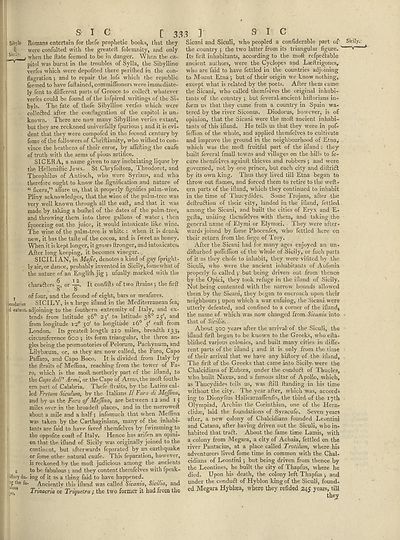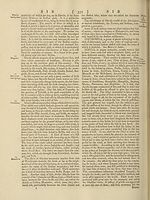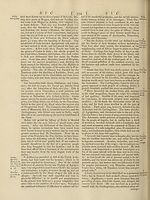Encyclopaedia Britannica, or, a Dictionary of arts, sciences, and miscellaneous literature : enlarged and improved. Illustrated with nearly six hundred engravings > Volume 19, Scripture-SUG
(377) Page 333
Download files
Complete book:
Individual page:
Thumbnail gallery: Grid view | List view

Sibyls
II
! Sicily-
SIC [ 33
Romans entertain for tliefe prophetic books, that they
were confulted with the greateft folemnity, and only
when the date feemed to be in danger. When the ea-
pitol was burnt in the troubles of Sylla, the Sibylline
verfes which were depofited there perifhed in the con¬
flagration ; and to repair the lofs which the republic,
feemed to have fuftained, commiflioners were immediate¬
ly fent to different parts of Greece to colledf whatever
verfes could be found of the infpired writings of the SU
byls. The fate of thefe Sibylline verfes which were
collefted after the conflagration of the capitol is un¬
known. There are now many Sibylline verfes extant,
but they are reckoned univerfally fnurious •, and it is evi¬
dent that they were compofed in the fecond century by
fome of the followers of Chriftianity, who wilhed to con¬
vince the heathens of their error, by aflifting the caufe
of truth with the arms of pious artifice.
SI CERA, a name given to any inebriating liquor by
thef Helleniftic Jews. St Chryfoftora, Theodoret, and
Theophilus of Antioch, who were Syrians, and who
therefore ought to know the fignification and nature of
“ ficera,” affure us, that it properly fignifies palm-wine.
Pliny acknowledges, that the wine of the palm-tree was
very w'ell known through all the eaft, and that it was
made by taking a bulhel of the dates of the palm-tree,
and throwing them into three gallons of water ; then
fqueezing out the juice, it would intoxicate like wine.
The wine of the palm-tree is white : when it is drunk
new, it has the tafte of the cocoa, and is fweet as honey.
When it is kept longer, it grows fironger, and intoxicates*
After long keeping, it becomes vinegar. ,
SICILIAN, in Mujic, denotes a kind of gay fpright-
ly air, or dance, probably invented in Sicily, foraewhat of
the nature of an Englifh jig •, ufually marked with the
characters or It confifts of two drains 5 the firft
O 8
T of four, and the feeond of eight, bars or meafures.
iundaries SICILY, is a large ifland in the Mediterranean fea,
id extent, adjoining to the fouthern extremity of Italy, and ex¬
tends from latitude 36° 25' to latitude 38° 25', and
from longitude 12° 30' to longitude 160 5' eafl from
London. Its greateft length 210 miles, breadth 133,
circumference 600 j its form triangular, the three an¬
gles being the promontories of Pelorum, Pachynum, and
Lilybaeum, or, as they are now called, the Faro, Capo
Paifaro, and Capo Boco. It is divided from Italy by
the ftraits of Medina, reaching from the tower of Fa¬
ro, which is the moft northerly part of the ifland, to
the Capo del!' Armi, or the Cape of Arms, the moft fouth¬
ern part of Calabria. Thefe ftraits, by the Latins cal¬
led Fretum Siculum, by the Italians // Faro di Mejfina,
and by us the Faro of Me fin a, are between x 2 and 15
miles over in the broadeft places, and in the narroweft
about a mile and a half; infomuch that when Medina
was taken by the Carthaginians, many of the inhabi¬
tants are faid to have faved themfelves by fwimming to
the oppofite coaft of Italy. Hence has arifen an opini¬
on that the ifland of Sicily was originally joined to the
continent, but afterwards feparated by an earthquake
or fome other natural caufe. This feparation, however,
is reckoned by the moft judicious among the ancients
2 to be fabulous ; and they content themfelves with fpeak-
1 iftorydu- ing of it as a thing faid to have happened,
tfous ^ Anciently this ifland was called Sicama, Sicilia, and
e°(us Trinacria or Triquetra ; the two former it had from the
3 ] SI c
Sicani and Siculi, who peopled a confiderable part of'
the country ; the two latter from its triangular figure. 4
Its firft inhabitants, according to the moft refpedlable
ancient authors, xvere the Cyclopes and Lseftrigones,.
who are faid to have fettled in the countries adjoining
to Mount Etna ; but of their origin w-e know nothing,
except what is related by the poets. After them came
the Sicani, who called themfelves the original inhabi¬
tants of the country ; but feveral ancient hiftorians in¬
form us that they came from a country in Spain wa¬
tered by the river Siconus. Diodorus, however, is of
opinion, that the Sicani were the moft ancient inhabi¬
tants of this ifland. He tells us that they were in pof-
feflion of the whole, and applied themfelves to cultivate
and improve the ground in the neighbourhood of Etna,
which was the moft fruitful part of the ifland : they
built feveral fmall towns and villages- on the hills to fe-
cure themfelves againft thieves and robbers j and were
governed, not by one prince, but each city and diftriift
by its own king. Thus they lived till Etna began to
throw out flames, and forced them to retire to the weft-
ern parts of the ifland, which they continued to inhabit
in the time of Thucydides. Some Trojans, after the
deftruftion of their, city, landed in the ifland, fettled
among the Sicani, and built the cities of Eryx and E-
gefta, uniting themfelves with them, and taking the
general name of Elymi or Elymaei. They were after¬
wards joined by fome Phocenfes, who fettled here on
their return from the fiege of Troy.
After the Sicani had for many ages enjoyed an un-
difturbed pofieflion of the whole of Sicily, or fuch parts
of it as they chofe to inhabit, they were vifited by the
Siculi, who were the ancient inhabitants of Aufonia
properly fo called } but being driven out from thence
by the Opici, they took refuge in the ifland of Sicily.
Not being contented with the narrow bounds allowed
them by the Sieani, they began to encroach upon their
neighbours; upon which a war enfuing, the Sicani were
utterly defeated, and confined to a corner of the ifland*
the name of which was now changed from Sicania into
that of Sicilia.
About 300 years after the arrival of the Siculi, the
ifland firft began to be known to the Greeks, who efta-
bliflied various colonies, and built many cities in diffe¬
rent parts of the ifland ; and it is only from the time
of their arrival that we have any hiftory of the ifland,
The firft of the Greeks that came into Sicily, were the
Chalcidians of Eubcea, under the conduft of Thucles,
who built Naxus, and a famous altar of Apollo, which,
as Thucydides tells us, was ftill ftanding in his time
without the city. The year after, which was, accords
ing to Dionyfius Halicarnaffenfis, the third of the 17th
Olympiad, Archias the Corinthian, one of the Hera-
clrdse, laid the foundations of Syracufe. Seven years
after, a new colony of Chalcidians founded Leontini
and Catana, after having driven out the Siculi, who in¬
habited that tra<EL About the fame time Lamis, with
a colony from Megara, a city of Achaia, fettled on the
river Pantacius, at a place called Troti/um, where his
adventurers lived fome time in common with the Chal¬
cidians of Leontini *, but being driven from thence by
the Leontines, he built the city of Thapfus, where he
died. Upon his death, the colony left Thapfus -r and
under the conduct of Hyblon king of the Siculi, found¬
ed Megara Hyblaea, where they refided 245 years, till
they
Sicily.'
—Y—
II
! Sicily-
SIC [ 33
Romans entertain for tliefe prophetic books, that they
were confulted with the greateft folemnity, and only
when the date feemed to be in danger. When the ea-
pitol was burnt in the troubles of Sylla, the Sibylline
verfes which were depofited there perifhed in the con¬
flagration ; and to repair the lofs which the republic,
feemed to have fuftained, commiflioners were immediate¬
ly fent to different parts of Greece to colledf whatever
verfes could be found of the infpired writings of the SU
byls. The fate of thefe Sibylline verfes which were
collefted after the conflagration of the capitol is un¬
known. There are now many Sibylline verfes extant,
but they are reckoned univerfally fnurious •, and it is evi¬
dent that they were compofed in the fecond century by
fome of the followers of Chriftianity, who wilhed to con¬
vince the heathens of their error, by aflifting the caufe
of truth with the arms of pious artifice.
SI CERA, a name given to any inebriating liquor by
thef Helleniftic Jews. St Chryfoftora, Theodoret, and
Theophilus of Antioch, who were Syrians, and who
therefore ought to know the fignification and nature of
“ ficera,” affure us, that it properly fignifies palm-wine.
Pliny acknowledges, that the wine of the palm-tree was
very w'ell known through all the eaft, and that it was
made by taking a bulhel of the dates of the palm-tree,
and throwing them into three gallons of water ; then
fqueezing out the juice, it would intoxicate like wine.
The wine of the palm-tree is white : when it is drunk
new, it has the tafte of the cocoa, and is fweet as honey.
When it is kept longer, it grows fironger, and intoxicates*
After long keeping, it becomes vinegar. ,
SICILIAN, in Mujic, denotes a kind of gay fpright-
ly air, or dance, probably invented in Sicily, foraewhat of
the nature of an Englifh jig •, ufually marked with the
characters or It confifts of two drains 5 the firft
O 8
T of four, and the feeond of eight, bars or meafures.
iundaries SICILY, is a large ifland in the Mediterranean fea,
id extent, adjoining to the fouthern extremity of Italy, and ex¬
tends from latitude 36° 25' to latitude 38° 25', and
from longitude 12° 30' to longitude 160 5' eafl from
London. Its greateft length 210 miles, breadth 133,
circumference 600 j its form triangular, the three an¬
gles being the promontories of Pelorum, Pachynum, and
Lilybaeum, or, as they are now called, the Faro, Capo
Paifaro, and Capo Boco. It is divided from Italy by
the ftraits of Medina, reaching from the tower of Fa¬
ro, which is the moft northerly part of the ifland, to
the Capo del!' Armi, or the Cape of Arms, the moft fouth¬
ern part of Calabria. Thefe ftraits, by the Latins cal¬
led Fretum Siculum, by the Italians // Faro di Mejfina,
and by us the Faro of Me fin a, are between x 2 and 15
miles over in the broadeft places, and in the narroweft
about a mile and a half; infomuch that when Medina
was taken by the Carthaginians, many of the inhabi¬
tants are faid to have faved themfelves by fwimming to
the oppofite coaft of Italy. Hence has arifen an opini¬
on that the ifland of Sicily was originally joined to the
continent, but afterwards feparated by an earthquake
or fome other natural caufe. This feparation, however,
is reckoned by the moft judicious among the ancients
2 to be fabulous ; and they content themfelves with fpeak-
1 iftorydu- ing of it as a thing faid to have happened,
tfous ^ Anciently this ifland was called Sicama, Sicilia, and
e°(us Trinacria or Triquetra ; the two former it had from the
3 ] SI c
Sicani and Siculi, who peopled a confiderable part of'
the country ; the two latter from its triangular figure. 4
Its firft inhabitants, according to the moft refpedlable
ancient authors, xvere the Cyclopes and Lseftrigones,.
who are faid to have fettled in the countries adjoining
to Mount Etna ; but of their origin w-e know nothing,
except what is related by the poets. After them came
the Sicani, who called themfelves the original inhabi¬
tants of the country ; but feveral ancient hiftorians in¬
form us that they came from a country in Spain wa¬
tered by the river Siconus. Diodorus, however, is of
opinion, that the Sicani were the moft ancient inhabi¬
tants of this ifland. He tells us that they were in pof-
feflion of the whole, and applied themfelves to cultivate
and improve the ground in the neighbourhood of Etna,
which was the moft fruitful part of the ifland : they
built feveral fmall towns and villages- on the hills to fe-
cure themfelves againft thieves and robbers j and were
governed, not by one prince, but each city and diftriift
by its own king. Thus they lived till Etna began to
throw out flames, and forced them to retire to the weft-
ern parts of the ifland, which they continued to inhabit
in the time of Thucydides. Some Trojans, after the
deftruftion of their, city, landed in the ifland, fettled
among the Sicani, and built the cities of Eryx and E-
gefta, uniting themfelves with them, and taking the
general name of Elymi or Elymaei. They were after¬
wards joined by fome Phocenfes, who fettled here on
their return from the fiege of Troy.
After the Sicani had for many ages enjoyed an un-
difturbed pofieflion of the whole of Sicily, or fuch parts
of it as they chofe to inhabit, they were vifited by the
Siculi, who were the ancient inhabitants of Aufonia
properly fo called } but being driven out from thence
by the Opici, they took refuge in the ifland of Sicily.
Not being contented with the narrow bounds allowed
them by the Sieani, they began to encroach upon their
neighbours; upon which a war enfuing, the Sicani were
utterly defeated, and confined to a corner of the ifland*
the name of which was now changed from Sicania into
that of Sicilia.
About 300 years after the arrival of the Siculi, the
ifland firft began to be known to the Greeks, who efta-
bliflied various colonies, and built many cities in diffe¬
rent parts of the ifland ; and it is only from the time
of their arrival that we have any hiftory of the ifland,
The firft of the Greeks that came into Sicily, were the
Chalcidians of Eubcea, under the conduft of Thucles,
who built Naxus, and a famous altar of Apollo, which,
as Thucydides tells us, was ftill ftanding in his time
without the city. The year after, which was, accords
ing to Dionyfius Halicarnaffenfis, the third of the 17th
Olympiad, Archias the Corinthian, one of the Hera-
clrdse, laid the foundations of Syracufe. Seven years
after, a new colony of Chalcidians founded Leontini
and Catana, after having driven out the Siculi, who in¬
habited that tra<EL About the fame time Lamis, with
a colony from Megara, a city of Achaia, fettled on the
river Pantacius, at a place called Troti/um, where his
adventurers lived fome time in common with the Chal¬
cidians of Leontini *, but being driven from thence by
the Leontines, he built the city of Thapfus, where he
died. Upon his death, the colony left Thapfus -r and
under the conduct of Hyblon king of the Siculi, found¬
ed Megara Hyblaea, where they refided 245 years, till
they
Sicily.'
—Y—
Set display mode to:
![]() Universal Viewer |
Universal Viewer | ![]() Mirador |
Large image | Transcription
Mirador |
Large image | Transcription
Images and transcriptions on this page, including medium image downloads, may be used under the Creative Commons Attribution 4.0 International Licence unless otherwise stated. ![]()
| Permanent URL | https://digital.nls.uk/192700183 |
|---|
| Attribution and copyright: |
|
|---|
| Description | Ten editions of 'Encyclopaedia Britannica', issued from 1768-1903, in 231 volumes. Originally issued in 100 weekly parts (3 volumes) between 1768 and 1771 by publishers: Colin Macfarquhar and Andrew Bell (Edinburgh); editor: William Smellie: engraver: Andrew Bell. Expanded editions in the 19th century featured more volumes and contributions from leading experts in their fields. Managed and published in Edinburgh up to the 9th edition (25 volumes, from 1875-1889); the 10th edition (1902-1903) re-issued the 9th edition, with 11 supplementary volumes. |
|---|---|
| Additional NLS resources: |
|

